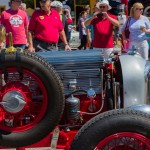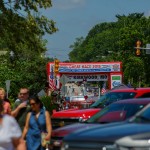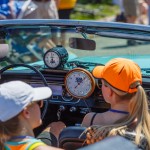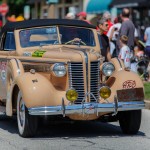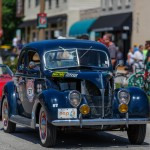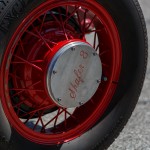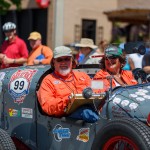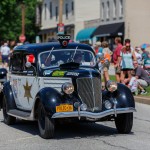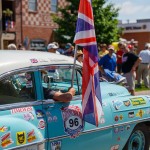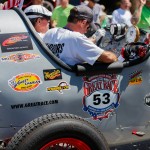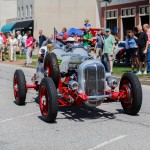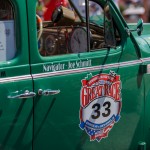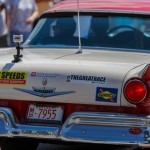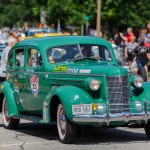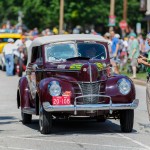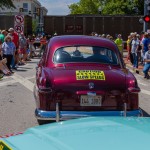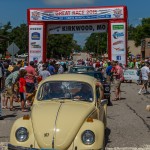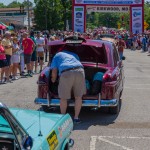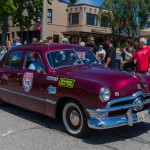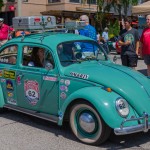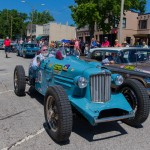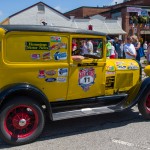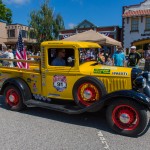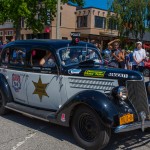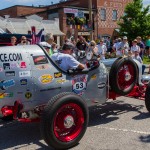Category Archives: McGraphics
The Great Race Starts at Kirkwood, Missouri
The Great Race started in Kirkwood, Missouri on the 20th of June. You may ask what is the Great Race, well is an antique, vintage, and collector car competitive controlled-speed endurance road rally on public highways. It is not a test of top speed. It is a test of a driver/navigator team’s ability to follow precise course instructions. Each day the driver and navigator team receives a set of course instructions that indicate every turn, speed change, stop, and start that the team must make throughout the day (usually 220 to 250 such instructions per day). Along the course route there will be from 4 to 7 checkpoints recording the exact time that the team passes that point.
For more information go to there website.
Here are some of my photos from the start of the race.
- Great Race – Kirkwood MO
- Great Race – Kirkwood, Mo
- Great Race – Kirkwood, Mo
- Great Race – Kirkwood, Mo
- Great Race – Kirkwood, Mo
- Great Race – Kirkwood, Mo
- Great Race – Kirkwood, Mo
- Great Race – Kirkwood, Mo
- Great Race – Kirkwood, Mo
- Great Race – Kirkwood, Mo
- Great Race – Kirkwood, Mo
- Great Race – Kirkwood, Mo
- Great Race – Kirkwood, Mo
- Great Race – Kirkwood, Mo
- Great Race – Kirkwood, Mo
- Great Race – Kirkwood, Mo
- Great Race – Kirkwood, Mo
- Great Race – Kirkwood, Mo
- Great Race – Kirkwood, Mo
- Great Race – Kirkwood, Mo
- Great Race – Kirkwood, Mo
- Great Race – Kirkwood, Mo
- Great Race – Kirkwood MO
- Great Race – Kirkwood MO
- Great Race – Kirkwood MO
Let’s Talk Video Graphics
Here you will see examples of all kinds of graphics that can be used to put pizazz into your video.
Picturing Cuba: Havana and Viñales | Santa Fe Photographic Workshops Santa Fe, New Mexico
I will be joining Arthur Meyerson on this trip.
The program is excellent. It truly is a person-to-person exchange, and I loved meeting the people of Cuba on the streets, talking to them, and photographing them. It was wonderful. Kathryn Hill, past Cuba Program participant
As the eyes of the world turn to the small but resilient island in the Caribbean Sea, Picturing Cuba offers you the rare opportunity to engage with the Cuban people and to discover the country’s cultural diversity and physical beauty with your camera. Alluring, urban Havana and serene, verdant Viñales are our primary locations to explore. Join photographer and seasoned Cuba traveler Arthur Meyerson for a memorable journey to this beguiling country before it changes forever.
via Picturing Cuba: Havana and Viñales | Santa Fe Photographic Workshops Santa Fe, New Mexico.
Maine Media Workshops | Arthur Meyerson
Maine Media Workshop in Rockport, Maine was a terrific week. You could ask anything more for the experience. There was hard work figuring out what you where going to shoot to having a lot of fun with the people in the class. It is one of the workshops I will go back to again. The Main Media workshop gives you so many subjects to choose from. The Maine Media Workshops is an international non-profit educational organization offering year-round workshops for photographers, filmmakers, and media artists. Students from across the country and around the world travel to the harbor village of Rockport, Maine to attend courses at all levels, from absolute beginner and serious amateur to working professional. The Young Artists Program offers creative course opportunities for high school students. Professional certificate and MFA programs in photography, film, and multimedia are available through Maine Media College. The school’s curriculum honors historical forms and practices of image making while embracing new technologies and modes of creative expression.
Arthur Meyerson is recognized as one of America’s finest photographers. Since 1974, this native Texan has traveled throughout the world, creating award winning advertising, corporate and editorial photographs, as well as an extensive body of fine art imagery. A three-time winner of Adweek’s “Southwest Photographer of the Year” award, he is on Communication World’s list of top 10 corporate photographers and was named one of the 30 best advertising photographers by American Photo.
Arthur was my instructor for the workshop. The workshop was challenged us to ease out of our comfort zones and abandon our familiar habits in order to introduce new ways of shooting our photos. Once we started to realize Arthur’s method of encouraging creativity through fresh ways of thinking, it became more and more enjoyable. Group critiques took place the day after shooting and they reinforced this, as well as brought fresh perspective to our work. The highlight for me was when I had a one-on-one session with Arthur the third day of class. That hour really helped me to see the good, the bad and the ugly of my work. Arthur’s influence has shown me how to elevate the way I see, think and shoot my photos. Overall, the collective nature of this particular workshop energized me and helped me to visualize my photos in innovative ways.
Just look at it this way; as a photographer I got dull after a while and had bad habits. Arthur has shown me how to improve my photographs. The rest is up to me.
See the photos at Photography by McGraphics
For sale at – Stock Photo
Maui | Hawaii | Surfing | Lava | Whales | Coastline | Pacific Ocean
The island of Maui is the second-largest of the Hawaiian Islands at 727.2 square miles (1,883 km2) and is the 17th largest island in the United States. Maui is part of the State of Hawaii and is the largest of Maui County’s four islands, bigger than Molokaʻi, Lānaʻi, and unpopulated Kahoʻolawe.
Polynesians, from Tahiti and the Marquesas, were the original peoples to populate Maui. The Tahitians introduced the kapu system, a strict social order that affected all aspects of life and became the core of Hawaiian culture. Modern Hawaiian history began in the mid-18th century. King Kamehameha I, king of Hawaii’s “Big Island,” invaded Maui in 1790 and fought the inconclusive Battle of Kepaniwai, but returned to Hawaii to battle a rival, finally subduing Maui a few years later.
On November 26, 1778, explorer Captain James Cook became the first European to see Maui. Cook never set foot on the island because he was unable to find a suitable landing. The first European to visit Maui was the French admiral Jean-François de La Pérouse, who landed on the shores of what is now known as La Perouse Bay on May 29, 1786. More Europeans followed: traders, whalers, loggers (e.g., of sandalwood) and missionaries. The latter began to arrive from New England in 1823, settling in Lahaina, which at that time was the capital. They clothed the natives, banned them from dancing hula, and greatly altered the culture. The missionaries taught reading and writing, created the 12-letter Hawaiian alphabet, started a printing press in Lahaina, and began writing the islands’ history, which until then was transmitted orally. Ironically, the missionaries both altered and preserved the native culture. The religious work altered the culture while the literacy efforts preserved native history and language. Missionaries started the first school in Lahaina, which still exists today: Lahainaluna Mission School, which opened in 1831.
At the height of the whaling era (1843–1860), Lahaina was a major whaling center with anchorage in Lāhainā Roads; in one season over 400 ships visited Lahaina with 100 berthed at one time. Ships tended to stay for weeks rather than days, which explains the drinking and prostitution in the town at that time, against which the missionaries vainly battled. Whaling declined steeply at the end of the 19th century as petroleum replaced whale oil.
Kamehameha’s descendants reigned until 1872. They were followed by rulers from another ancient family of chiefs, including Queen Liliuokalani who ruled in 1893 when the monarchy was overthrown. One year later, the Republic of Hawaii was founded. The island was annexed by the United States in 1898 and made a territory in 1900. Hawaii became the 50th U.S. state in 1959.
In 1937, Vibora Luviminda trades union conducted the last labor strike of an ethnic nature in the Hawaiian Islands against four Maui sugarcane plantations, demanding higher wages and the dismissal of five foremen. Manuel Fagel and nine other strike leaders were arrested, and charged with kidnapping a worker. Fagel spent four months in jail while the strike continued. Eventually, Vibora Luviminda made its point and the workers won a 15% increase in wages after 85 days on strike, but there was no written contract signed.
Maui was centrally involved in the Pacific Theater of World War II as a staging center, training base, and for rest and relaxation. At the peak in 1943-44, more than 100,000 soldiers were there. The main base of the 4th Marine Division was in Haiku. Beaches (e.g., in Kīhei) were used to practice landings and train in marine demolition and sabotage.
See the photos at Photography by McGraphics
For sale at – Stock Photo
Lewis and Clark | Gateway to the West | St Louis Arch
The Captains Return Statue is underwater near the Eads Bridge. The statue by sculptor Harry Weber was dedicated at the Final Signature Event in St Louis on September 23, 2006. The statue is located very near the Gateway Arch, which commemorates the location of the old St Louis riverfront community. The site of William Clark’s house and Indian Council Chambers and Museum, built in 1816, is within view of the statue.
Also in the photo is Eads Bridge. The Eads Bridge was designed and built by one of America’s greatest engineers, James B. Eads. It was completed in 1874 at a cost of over $10 million dollars. The world famous bridge was the first major bridge to use steel in its construction, and to be built entirely using cantilever supports. Its pier supports, shown here are still some of the deepest in the world. One was sunk 100 feet below the surface of the water to reach bedrock. The bridge was rebuilt and reopened in 2003. It is a combined road, rail and pedestrian bridge.
See four version of the same photo
- Color Photo
- Black and White
- Digital Oil Painting
- HDR
See the photos at Photography by McGraphics
For sale at – Stock Photo
St Louis Missouri | Car Shows | Hot Rods | Street Rods | Custom Cars
Custom car is a passenger vehicle that has been modified in either of the following two ways. First, a custom car may be altered to improve its performance, often by altering or replacing the engine and transmission. Second, a custom car may be a personal “styling” statement, making the car look unlike any car as delivered from the factory. Although the two are related, custom cars are distinct from hot rods. The extent of this difference has been the subject of debate among customizers and rodders for decades. Additionally, a street rod can be considered a custom.
Hot rods are typically American cars with large engines modified for linear speed. The origin of the term “hot rod” is unclear. One explanation is that the term is a contraction of “hot roadster,” meaning a roadster that was modified for speed. Another possible origin includes modifications to or replacement of the camshaft(s), sometimes known as a “stick” or “rod”. A camshaft designed to produce more power is sometimes called a “hot stick” or a “hot rod”. Roadsters were the cars of choice because they were light. The term became commonplace in the 1930s or 1940s as the name of a car that had been “hopped up” by modifying the engine in various ways to achieve higher performance.
There is still a vibrant hot rod culture worldwide, especially in Canada, the United States, the United Kingdom, Australia and Sweden. The hot rod community has now been subdivided into two main groups: street rodders and hot rodders. Hot rodders build their cars using a lot of original equipment parts, whether from wrecking yards or NOS , and follow the styles that were popular from the 1940s through the 1960s. Street rodders build cars (or have them built for them) using primarily new parts.
A common factor among current owners of hot rods is to make them more noticeable. There are now many different sectors of hot rodding, some of which are:
- Street rod: a very popular branch of hot rodding. Contrary to the implications of the term hot rod, street rods are a mix of hot rods, custom cars, and modern Detroit cars. Emphasis is on high-quality custom paint jobs, comfortable interiors, and modern engines and running gear. As specified by the NSRA (National Street Rod Association), a street rod must have been manufactured prior to 1949.
- Pro-Street rod: a branch of street rodding featuring mildly customized sedan and coupe models not normally associated with hot rodding that have monster engines and huge rear tires inside the fender wells. They retain all the other luxury features of street rods.
- Billet rod: street rods featuring many items being machined from billet aluminum
- Traditional rod: built according to a particular point in time and stick to those build techniques and materials
- Rat rod: constructed to resemble an old time jalopies, although they may require more work than a show rod
- Show rods (created to compete in national car shows such as America’s Most Beautiful Roadster (AMBR), and the Detroit Autorama).
There are hundreds of local car clubs supporting the hot rod/street rod community. The National Street Rod Association (NSRA) is the largest club in the world and sponsors many local events including the Street Rod Nationals which serve as a showplaces for the majority of the hot-rodding and street-rodding world to display their cars and to find nearly any part needed to complete them. Collectively they are all referred to as Hot Rods.
Drag racing is a competition in which specially prepared automobiles or motorcycles compete, usually two at a time, to be first to cross a set finish line. The race follows a straight course from a standing start over a measured distance, mostcommonly ¼ mile (1,320 ft (400 m)) for most cars, with a shorter 1,000 ft (300 m) for some Top Fuel dragsters and funny cars. Electronic timing and speed sensing systems have been used to record race results since the 1960s.
Before each race (also known as a pass), each driver is allowed to perform a burnout, which heats the driving tires and lays rubber down at the beginning of the track, improving traction. Each driver then lines up (or stages) at the starting line. Races are started electronically by a system known as a Christmas tree. The Christmas tree consists of a column of lights for each driver/lane, one blue, then three amber, one green, and one red, connected to light beams on the track. The first, a split blue open circle, is split into two halves. When the first light beam is broken by the vehicle’s front tire(s) indicate that the driver has pre-staged (approximately 7 inches (180 mm) from the starting line), lights the first half of the blue circle, and then staged (at the starting line), which lights up the second half of the blue circle, and also the corresponding bar in the middle of that circle.
Below the blue “staged” light are three large amber lights, a green light, and a red light. When both drivers are staged, the tree is activated to start the race, which causes the three large amber lights to illuminate, followed by the green light. There are two standard light sequences: either the three amber lights flash simultaneously, followed 0.4 seconds later by the green light (a Pro tree), or the ambers light in sequence from top to bottom, 0.5 seconds apart, followed 0.5 seconds later by the green light (a Sportsman tree, or full tree). If the front tires leaves from a stage beam (stage and pre-stage lights both turned off) before the green light illuminates, the red light for that driver’s lane illuminates instead, indicating disqualification (unless a more serious violation occurs). Once a driver commits a red-light foul (also known as redlighting), the other driver can also commit a foul start by leaving the line too early but still win, having left later. The green light automatically is illuminated on the opposite side of the red-lightning driver. Should both drivers leave after the green light illuminates, the one leaving first is said to have a holeshot advantage.
The winner is the first vehicle to cross the finish line (and therefore the driver with the lowest total reaction time and elapsed time). The elapsed time is a measure of performance only; it does not necessarily determine the winner. Because elapsed time does not include reaction time and each lane is timed individually, a car with a slower elapsed time can actually win if that driver’s holeshot advantage exceeds the elapsed time difference. In heads-up racing, this is known as a holeshot win.
See the photos at Photography by McGraphics
For sale at – Stock Photo
WW 1 Memorial with the Gold Star Court Of Honor Plaques
When one man found 752 cast bronze disks in Soldier’s Memorial, he had no idea the years of effort involved to turn the forgotten artifacts into a memorial at Jefferson Barracks.
Seventeen years ago, Frank “Skip” Berger made an interesting discovery in the lower level of Soldiers’ Memorial in downtown St. Louis.
Fifteen unmarked barrels filled with 752 cast bronze disks stood in the dust. Each disk bore the name and military information of a St. Louis service member who lost his or her life while serving in World War I. The serendipitous find began a chain reaction of activity that would impress even professional historians.
The American Gold Star Mothers, a group who wished to honor their fallen sons and daughters, commissioned the markers, cast at a local foundry in the 1920s.
Berger is a member of the Rollo-Calcaterra American Legion Post 15 and the group began an extensive research and restoration mission.
The effort will come to fruition Sept. 30 at 1:30 p.m. when Post 15 will dedicate the World War I Court of Honor Memorial in Jefferson Barracks National Cemetery.
The Post preserved 752 of the 1,185 gold star medallions. They worked in conjunction with the Jefferson Barracks Chapel Association, the National Cemetery Association, the Veterans Administration and the St. Louis Economic Council.
The Port Authority, under the economic council, awarded the group $250,000 for the memorial, and construction started in May.
via WWI Memorial Complete After Buried Treasure Discovery – Mehlville-Oakville, MO Patch.
See the photos at Photography by McGraphics
Dancing Bear Lodge | Smoky Mountains | Photo Trip
Stirred by the sapphire mist that envelops our mountain vistas, the Cherokee people named the Great Smoky Mountains the place of blue smoke. At our Townsend, Tennessee lodging, we call them our back yard. Whether visiting the Smokies for relaxation, sport, romance or business, Dancing Bear Lodge hotel in Townsend, Tennessee, inspires getaways as expansive and free-spirited as the Smokies themselves. Experience one of the gems of Great Smoky Mountain Cabin Resort hotels!
Our Smoky Mountain accommodations are ideally located for both a relaxing retreat and an engaging open-air adventure. Dancing Bear Cabin Resort offers a number of impressively-constructed, luxurious cabin rentals in the Smoky Mountain lodges that are adjacent to Little River in Townsend, Tennessee. Only 5 minutes from the entrance to the Great Smoky Mountains National Park and 25 minutes from the Knoxville Airport, our 36-acre estate is sure to provide you and your family or associates with an unforgettable escape at our Lodging in Townsend, Tennessee. You will quickly see why our Smoky Mountain Lodges are better than other Townsend hotels.
Enjoy America’s most visited national park—The Great Smoky Mountains, only 5 minutes from our Townsend, Tennessee lodge. You’ll find an astonishing diversity of plant and animal life, unparalleled beauty and a bevy of guided programs and special events. A hiking and bicycling paradise awaits! While enjoying the best the Smoky Mountains region has to offer, enjoy a luxurious and relaxing refuge with our Townsend, TN Hotels Amenities when you retreat to your cabin or room at our well-appointed Smoky Mountain Lodge.
If you’re looking for outdoor adventure nearby, Dancing Bear offers paved biking trails, wildflower walks and mountain biking on our 36-acre property. Unwind with your favorite book on a front porch rocker, get the adrenaline flowing with a spirited game of beach volleyball or test your angling skills by fly fishing with water shoes in the Little River. Whether it’s a bubbling hot tub or a blazing campfire that marks day’s end for you, our lodge helps round out your Smoky Mountain experience—all without leaving your home away from home. Dining in the Smokies is no less exciting, with authentic regional favorites that are lovingly crafted by our own chef.
via Hotels in Townsend, TN – Smoky Mountain Cabin Resort The Dancing Bear Lodge Gatlinburg.
The Great Smoky Mountains
The Great Smoky Mountains are a mountain range rising along the Tennessee–North Carolina border in the southeastern United States. They are a subrange of the Appalachian Mountains, and form part of the Blue Ridge Physiographic Province. The range is sometimes called the Smoky or Smokey Mountains, and the name is commonly shortened to the Smokies. The Great Smokies are best known as the home of the Great Smoky Mountains National Park, which protects most of the range. The park was established in 1934, and, with over 9 million visits per year, it is the most-visited national park in the United States.
The Great Smokies are part of an International Biosphere Reserve. The range is home to an estimated 187,000 acres of old growth forest, constituting the largest such stand east of the Mississippi River. The cove hardwood forests in the range’s lower elevations are among the most diverse ecosystems in North America, and the Southern Appalachian spruce-fir forest that coats the range’s upper elevations is the largest of its kind.[4] The Great Smokies are also home to the densest black bear population in the Eastern United States and the most diverse salamander population outside of the tropics.
Along with the Biosphere reserve, the Great Smokies have been designated a UNESCO World Heritage Site. The U.S. National Park Service preserves and maintains 78 structures within the national park that were once part of the numerous small Appalachian communities scattered throughout the range’s river valleys and coves. The park contains five historic districts and nine individual listings on the National Register of Historic Places.
The name “Smoky” comes from the natural fog that often hangs over the range and presents as large smoke plumes from a distance. This fog, which is most common in the morning and after rainfall, is the result of warm humid air from the Gulf of Mexico cooling rapidly in the higher elevations of Southern Appalachia.
See the photos at Photography by McGraphics
For sale at – Stock Photo
The Lantern Festival at the Missouri Botanical Garden | Photo Outing
The Lantern Festival (also known as the Yuanxiao Festival or Shangyuan Festival in China; Chap Goh Meh Festival in Indonesia, Malaysia and Singapore; Yuen Siu Festival in Hong Kong, and “Tết Thượng Nguyên” or “Tết Nguyên Tiêu” in Vietnam; corresponding Japanese event Koshōgatsu); is a festival celebrated on the fifteenth day of the first month in the lunisolar year in the Chinese calendar, the last day of the lunisolar Chinese New Year celebration. It is not to be confused with the Mid-Autumn Festival, which is sometimes also known as the “Lantern Festival” in locations such as Singapore and Malaysia. During the Lantern Festival, children go out at night to temples carrying paper lanterns and solve riddles on the lanterns (simplified Chinese: 猜灯谜; traditional Chinese: 猜燈謎; pinyin: cāidēngmí). It officially ends the Chinese New Year celebrations.
In ancient times, the lanterns were fairly simple, and only the emperor and noblemen had large ornate ones; in modern times, lanterns have been being embellished with many complex designs. For example, lanterns are now often made in shapes of animals. The lanterns can symbolize the people letting go of their past selves and getting a new one, which they will let go of the next year.
Throughout the history of China, lanterns have been symbols of hope, rejuvenation, and celebration. Lanterns are integral to the most mundane or important rituals of life; in support of communication with the god; for ceremonial purposes; as symbols; and in festivals.
The Lantern Festival falls on the 15th day of the 1st lunar month, usually in February or March in the Gregorian calendar. As early as the Western Han Dynasty (206 BC-AD 25), it had become a festival with great significance.
This day’s important activity is watching lanterns. Throughout the Han Dynasty (206 BC-AD 220), Buddhism flourished in China. One emperor heard that Buddhist monks would watch sarira, or remains from the cremation of Buddha‘s body, and light lanterns to worship Buddha on the 15th day of the 1st lunar month, so he ordered to light lanterns in the imperial palace and temples to show respect to Buddha on this day. Later, the Buddhist rite developed into a grand festival among common people and its influence expanded from the Central Plains to the whole of China.
Today, the lantern festival is still held each year around the country. Lanterns of various shapes and sizes are hung in the streets, attracting countless visitors. Children will hold self-made or bought lanterns to stroll with on the streets, extremely excited.
Commemorating its 25th year of work on the Flora of China project, in 2012 the Garden hosted Lantern Festival: Art by Day, Magic by Night, a unique opportunity to witness a spectacle rarely staged outside Asia.
via Lantern Festival: Art by Day, Magic by Night.
See the photos at Photography by McGraphics
For sale at – Stock Photo
55 Stunning Botanical Gardens to See Before You Die

